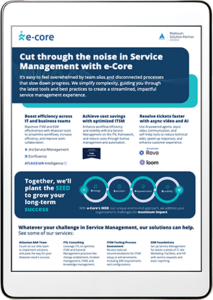Cut through the noise in Service Management with e-Core
e-Core • November 13, 2024
Discover how to simplify service management complexity with e-Core. This one-pager covers best practices and tools for achieving efficiency, cost savings, and faster ticket resolution across IT and business teams. Learn how, asynchronous video communication and AI-powered Atlassian solutions can enhance collaboration, visibility, and customer experience.
Download now to see how to maximize ITSM and ESM effectiveness tailored to your business needs. →

e-Core
We combine global expertise with emerging technologies to help companies like yours create innovative digital products, modernize technology platforms, and improve efficiency in digital operations.







